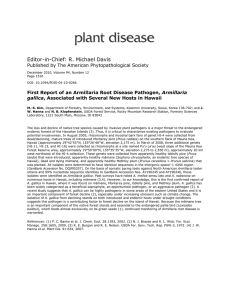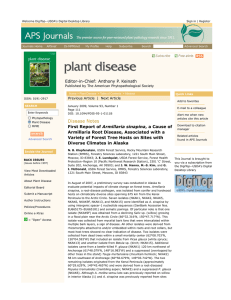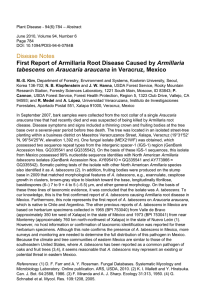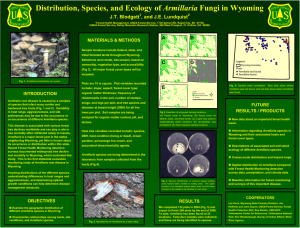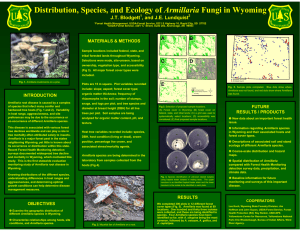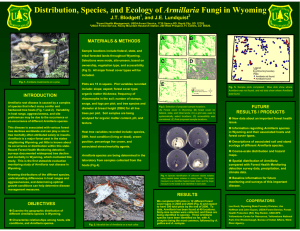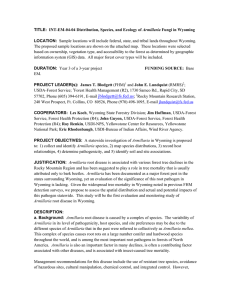Advances toward DNA-based identification and phylogeny
advertisement
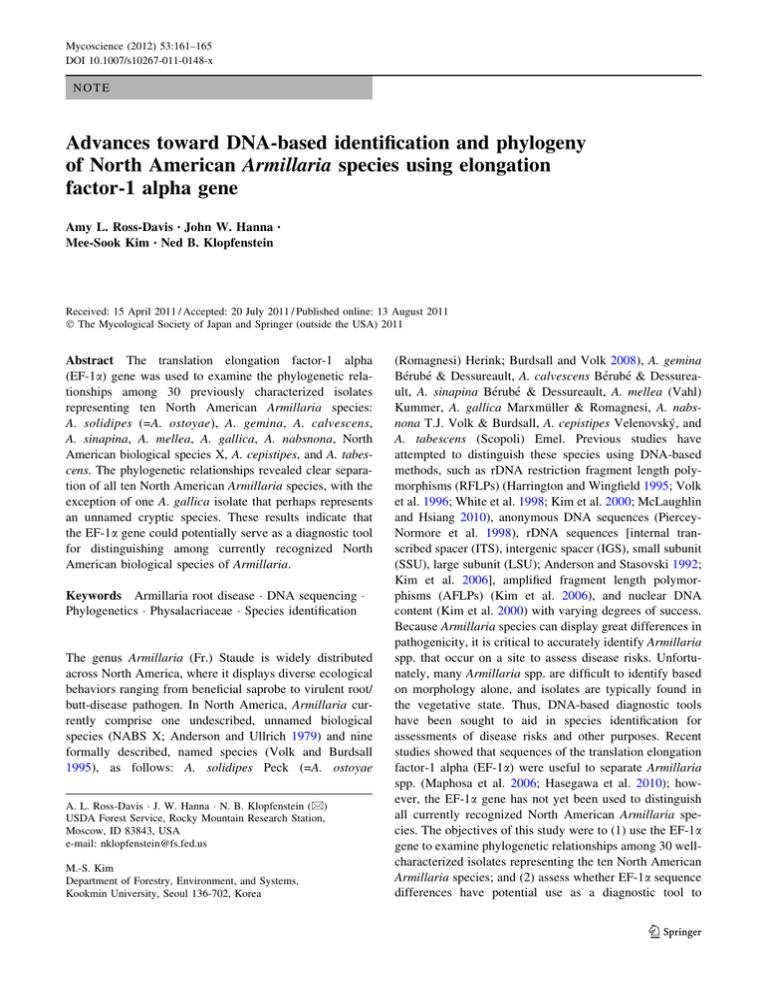
Mycoscience (2012) 53:161–165 DOI 10.1007/s10267-011-0148-x NOTE Advances toward DNA-based identification and phylogeny of North American Armillaria species using elongation factor-1 alpha gene Amy L. Ross-Davis • John W. Hanna Mee-Sook Kim • Ned B. Klopfenstein • Received: 15 April 2011 / Accepted: 20 July 2011 / Published online: 13 August 2011 Ó The Mycological Society of Japan and Springer (outside the USA) 2011 Abstract The translation elongation factor-1 alpha (EF-1a) gene was used to examine the phylogenetic relationships among 30 previously characterized isolates representing ten North American Armillaria species: A. solidipes (=A. ostoyae), A. gemina, A. calvescens, A. sinapina, A. mellea, A. gallica, A. nabsnona, North American biological species X, A. cepistipes, and A. tabescens. The phylogenetic relationships revealed clear separation of all ten North American Armillaria species, with the exception of one A. gallica isolate that perhaps represents an unnamed cryptic species. These results indicate that the EF-1a gene could potentially serve as a diagnostic tool for distinguishing among currently recognized North American biological species of Armillaria. Keywords Armillaria root disease DNA sequencing Phylogenetics Physalacriaceae Species identification The genus Armillaria (Fr.) Staude is widely distributed across North America, where it displays diverse ecological behaviors ranging from beneficial saprobe to virulent root/ butt-disease pathogen. In North America, Armillaria currently comprise one undescribed, unnamed biological species (NABS X; Anderson and Ullrich 1979) and nine formally described, named species (Volk and Burdsall 1995), as follows: A. solidipes Peck (=A. ostoyae A. L. Ross-Davis J. W. Hanna N. B. Klopfenstein (&) USDA Forest Service, Rocky Mountain Research Station, Moscow, ID 83843, USA e-mail: nklopfenstein@fs.fed.us M.-S. Kim Department of Forestry, Environment, and Systems, Kookmin University, Seoul 136-702, Korea (Romagnesi) Herink; Burdsall and Volk 2008), A. gemina Bérubé & Dessureault, A. calvescens Bérubé & Dessureault, A. sinapina Bérubé & Dessureault, A. mellea (Vahl) Kummer, A. gallica Marxmüller & Romagnesi, A. nabsnona T.J. Volk & Burdsall, A. cepistipes Velenovský, and A. tabescens (Scopoli) Emel. Previous studies have attempted to distinguish these species using DNA-based methods, such as rDNA restriction fragment length polymorphisms (RFLPs) (Harrington and Wingfield 1995; Volk et al. 1996; White et al. 1998; Kim et al. 2000; McLaughlin and Hsiang 2010), anonymous DNA sequences (PierceyNormore et al. 1998), rDNA sequences [internal transcribed spacer (ITS), intergenic spacer (IGS), small subunit (SSU), large subunit (LSU); Anderson and Stasovski 1992; Kim et al. 2006], amplified fragment length polymorphisms (AFLPs) (Kim et al. 2006), and nuclear DNA content (Kim et al. 2000) with varying degrees of success. Because Armillaria species can display great differences in pathogenicity, it is critical to accurately identify Armillaria spp. that occur on a site to assess disease risks. Unfortunately, many Armillaria spp. are difficult to identify based on morphology alone, and isolates are typically found in the vegetative state. Thus, DNA-based diagnostic tools have been sought to aid in species identification for assessments of disease risks and other purposes. Recent studies showed that sequences of the translation elongation factor-1 alpha (EF-1a) were useful to separate Armillaria spp. (Maphosa et al. 2006; Hasegawa et al. 2010); however, the EF-1a gene has not yet been used to distinguish all currently recognized North American Armillaria species. The objectives of this study were to (1) use the EF-1a gene to examine phylogenetic relationships among 30 wellcharacterized isolates representing the ten North American Armillaria species; and (2) assess whether EF-1a sequence differences have potential use as a diagnostic tool to 123 162 Mycoscience (2012) 53:161–165 distinguish among these North American Armillaria species, particularly those that are morphologically similar or closely related. To avoid ambiguity derived from misidentified isolates, this study focused on the only available set of North American Armillaria isolates that has been extensively characterized by multiple methods (Kim et al. 2006). Three isolates each of ten North American Armillaria species were included in this study (Table 1). More detailed information on the Armillaria isolates used in this study is available in Kim et al. (2006). We used the protocol of Kim et al. (2006) for fungal culture and DNA extraction. To amplify the EF-1a gene, each 50-ll polymerase chain reaction (PCR) mixture contained 5 ll (*100 ng) template DNA, 2.5 U Taq polymerase (Applied Biosystems, Foster City, CA, USA), PCR reaction buffer, 4 mM MgCl2, 200 lM dNTP, and 0.5 lM of each primer. Two sets of primers were used for PCR and sequencing: EF595F/ EF1160R (Kauserud and Schumacher 2001) and 983F/ Table 1 Armillaria isolates used in this study Species A. solidipes (=A. ostoyae) A. gemina A. calvescens A. sinapina A. mellea A. gallica More detailed information on the Armillaria isolates used in this study is available in Kim et al. 2006 NABS, North American biological species A. nabsnona NABS X a JF313133 (ST11A), JF313134 (ST11B); for isolate ST11, the method of Hanna et al. (2007) was used to decipher and edit a ‘‘frame-shift’’ caused by length variation between two gene copies, from which two separate sequences (ST11A and ST11B) were generated 123 A. cepistipes A. tabescens 2218R (Rehner and Buckley 2005). The PCR conditions were as follows: 94°C for 2 min; 30 cycles of 94°C for 30 s, 57°C for 30 s, and 72°C for 1 min and 30 s; then 72°C for 7 min. The PCR products of EF-1a gene were sequenced with an ABI 3700 DNA Sequencer at the University of Wisconsin, Biotechnology Center (Madison, WI, USA). Sequences were edited and aligned manually with BioEdit software (Hall 1999). For isolate ST11, the method of Hanna et al. (2007) was used to decipher and edit a ‘‘frame-shift’’ because of length variation between two gene copies, from which two separate sequences (ST11A and ST11B) were generated. These edited EF-1a gene sequences of the Armillaria isolates have been deposited in GenBank (see Table 1). Sequence alignments can be found in TreeBASE (S11603). The fungal cultures used in this study were deposited at the USDA Forest Service, Rocky Mountain Research Station, Forestry Sciences Laboratory, Moscow, Idaho, USA, and living subcultures are available upon request. Isolate Origin GenBank accession no. ST1 New Hampshire, USA JF313141 ST2 Washington, USA JF313139 P1404 Idaho, USA JF313140 ST8 New York, USA JF313136 ST9 New York, USA JF313135 ST11 West Virginia, USA JF313133a, JF313134a ST3 Quebec, Canada JF313138 ST17 ST18 Michigan, USA Michigan, USA JF313130 JF313129 M50 British Columbia, Canada JF313114 ST12 Washington, USA JF313132 ST13 Michigan, USA JF313131 ST5 Virginia, USA JF313137 ST20 Wisconsin, USA JF313128 ST21 New Hampshire, USA JF313127 M70 British Columbia, Canada JF313123 ST22 Michigan, USA JF313126 ST23 Wisconsin, USA JF313125 C21 Idaho, USA JF313119 M90 British Columbia, Canada JF313122 ST16 Alaska, USA JF313124 837 Idaho, USA JF313120 D82 POR100 Idaho, USA Idaho, USA JF313118 JF313117 M110 British Columbia, Canada JF313121 S20 British Columbia, Canada JF313116 W113 Washington, USA JF313115 ATMUS2 South Carolina, USA JF313113 OOI99 Georgia, USA JF313112 OOI210 Georgia, USA JF313111 Mycoscience (2012) 53:161–165 A Bayesian phylogenetic analysis was inferred using MrBayes 3.1.2 (Ronquist and Huelsenbeck 2003). To incorporate insertion and deletion events as phylogenetic characters, the sequence of each isolate was partitioned into two sections. The first section contained 1,065 DNA characters that were assigned to a STM ? G (symmetrical model plus gamma) nucleotide substitution model based on Akaike information criterion (AIC) data obtained using jModeltest 0.1.1 (Akaike 1974; Guindon and Gascuel 2003; Posada 2008). The second section consisted of eight binary characters representing gaps within the EF-1a alignment coded using a simple gap-coding method (Simmons and Ochoterena 2000). This section was assigned a simple F81-like substitution model in MrBayes (Felsenstein 1981). 163 With A. tabescens used as an outgroup, Bayesian analysis of the partial EF-1a gene revealed two additional major clades: (1) a clade containing A. solidipes (=A. ostoyae), A. gemina, A. sinapina, and A. mellea, and (2) a clade containing A. cepistipes, A. nabsnona, NABS X, A. calvescens, and A. gallica (Fig. 1). Partial sequence data for the EF-1a gene delineated all but one of the North American species of Armillaria into separate clades or subclades (Fig. 1). Isolates of A. gallica did not cluster within a single subclade (Fig. 1). The first major clade consisted of A. solidipes (=A. ostoyae) and A. mellea, which are aggressive pathogens, A. gemina, which is similar to A. solidipes (=A. ostoyae) (Kim et al. 2006), and A. sinapina, which has occasionally been associated with disease centers (Dettman and van der Kamp 2001). This Fig. 1 A 50% majority-rule consensus tree of ten North American Armillaria species based on 24,001 trees from Bayesian inference analysis of the translation elongation factor 1-alpha gene. Numbers between clades indicate posterior probability. Sequence alignments can be found in TreeBASE (S11603) 123 164 result differs from previous phylogenetic studies using rDNA sequences (Anderson and Stasovski 1992; Kim et al. 2006) and anonymous nucleotide sequences (PierceyNormore et al. 1998) in which A. sinapina clustered with A. calvescens, A. gallica, and A. cepistipes. The second major clade included A. cepistipes and A. nabsnona, saprobes or occasionally weak pathogens found on hardwoods in western North America. The second major clade also included the unnamed NABS X, known only from British Columbia, Washington, Oregon, California, and Idaho, as well as A. calvescens and A. gallica, which are morphologically very similar species. Interestingly, A. gallica (ST22 and ST23) from eastern North America grouped together, although the isolate (M70) from western North America was separate (Fig. 1). Although isolate M70 has been previously identified as A. gallica by pairing tests (Morrison et al. 1985) and nuclear DNA content (Kim et al. 2000), AFLP data also showed this isolate as genetically distinct from the other two A. gallica isolates (ST22 and ST23) (Kim et al. 2006). These data, as well as other DNA sequence data (Kim et al. 2006; Hanna et al. 2007), suggest that A. gallica is a diverse species that comprises multiple, genetically distinct groups which may include cryptic species (Hawksworth 2010). Confirmation of cryptic species within A. gallica will require sequence analysis of more genetic regions within multiple isolates from diverse sources. Further examination of more isolates could also determine if genetic divergence occurs between A. gallica isolates from eastern and western North America, as was observed with A. mellea (Baumgartner et al. 2010). The basal clade (outgroup) consists entirely of A. tabescens, the only exannulate species of Armillaria in North America. It is pathogenic on hardwoods, particularly on oaks and fruit trees, in eastern North America (Schnabel et al. 2005). Maximum likelihood and maximum parsimony analyses of the dataset showed similar results (data not shown). It should be noted that the primer set 983F/2218R is more appropriate to amplify and sequence the EF-1a gene for the North American Armillaria species than is the primer set EF595F/EF1160R. For these Armillaria species, the 983F primer is located upstream (50 -end) of the EF595F primer (despite numbering). The sequences from the 983F/ 2218R primer set overlap the EF595F/EF1160R primer locations and reveal a one-nucleotide difference from EF595F and two-nucleotide differences from EF1160R. Thus, improved primers should be designed for broader application to diverse Armillaria species and isolates. DNA-based identification of Armillaria is an essential step to monitor and predict Armillaria root disease in forest ecosystems. Previously, Kim et al. (2006) reported that rDNA sequence data are not sufficient to definitively 123 Mycoscience (2012) 53:161–165 confirm species identification among the closely related North American species A. calvescens, A. sinapina, A. gallica, and A. cepistipes. The results from this study indicate that the EF-1a gene could potentially serve as a diagnostic tool to distinguish among the North American species of Armillaria. Furthermore, the EF-1a gene sequences provide additional evidence that NABS X is genetically distinct from other North American Armillaria species, which indicates that NABS X should be formally described when sufficient supporting information is available. Because this study focused on previously characterized isolates to ensure the validity of results, further work associated with morphological characterization, genetic characterization, and mating/pairing tests of more isolates representing the intra- and interspecific diversity of North American Armillaria is required to verify the utility of this region as a diagnostic tool. Acknowledgments The project was supported by USDA Forest Service-RMRS, Forest and Woodland Ecosystems Program, Research Joint Venture Agreement (07-JV-11221662-285), and the Special Technology Development Program of the USDA Forest Service, S&PF Forest Health Monitoring. References Akaike H (1974) A new look at the statistical model identification. IEEE Trans Automat Control 19:716–723 Anderson JB, Stasovski E (1992) Molecular phylogeny of northern hemisphere species of Armillaria. Mycologia 84:505–516 Anderson JB, Ullrich RC (1979) Biological species of Armillaria mellea in North America. Mycologia 71:402–414 Baumgartner K, Travadon R, Bruhn J, Bergemann SE (2010) Contrasting patterns of genetic diversity and population structure of Armillaria mellea sensu stricto in the eastern and western United States. Phytopathology 100:708–718 Burdsall HH Jr, Volk TJ (2008) Armillaria solidipes, an older name for the fungus called Armillaria ostoyae. N Am Fungi 3:261–267 Dettman JR, van der Kamp BJ (2001) The population structure of Armillaria ostoyae and Armillaria sinapina in the central interior of British Columbia. Can J Bot 79:600–611 Felsenstein J (1981) Evolutionary trees from DNA sequences: a maximum likelihood approach. J Mol Evol 17:368–376 Guindon S, Gascuel O (2003) A simple, fast, and accurate algorithm to estimate large phylogenies by maximum likelihood. Syst Biol 52:696–704 Hall TA (1999) BioEdit: a user-friendly biological sequence alignment editor and analysis program for Windows 95/98/NT. Nucleic Acids Symp Ser 41:95–98 Hanna JW, Klopfenstein NB, Kim M-S, McDonald GI, Moore JA (2007) Phylogeographic patterns of Armillaria ostoyae in the western United States. For Pathol 37:192–216 Harrington TC, Wingfield BD (1995) A PCR-based identification method for species of Armillaria. Mycologia 87:280–288 Hasegawa E, Ota Y, Hattori T, Kikuchi T (2010) Sequence-based identification of Japanese Armillaria species using the elongation factor-1 alpha gene. Mycologia 102:898–910 Hawksworth DL (2010) Cryptic speciation: how common is it and how should it be handled taxonomically? http://imc9.info/prog_ sig3_detail_hawksworth.htm Mycoscience (2012) 53:161–165 Kauserud H, Schumacher T (2001) Outcrossing or inbreeding: DNA markers provide evidence for type of reproductive mode in Phellinus nigrolimitatus (Basidiomycota). Mycol Res 105: 676–683 Kim M-S, Klopfenstein NB, McDonald GI, Arumuganathan K, Vidaver AK (2000) Characterization of North American Armillaria species by nuclear DNA content and RFLP analysis. Mycologia 92:874–883 Kim M-S, Klopfenstein NB, Hanna JW, McDonald GI (2006) Characterization of North American Armillaria species: genetic relationships determined by ribosomal DNA sequences and AFLP markers. For Pathol 36:145–164 Maphosa L, Wingfield BD, Coetzee MPA, Mwenje E, Wingfield MJ (2006) Phylogenetic relationships among Armillaria species inferred from partial elongation factor 1-alpha DNA sequence data. Aust Plant Pathol 35:513–520 McLaughlin JA, Hsiang T (2010) Identification protocol for six Armillaria species from northeastern North America. Can J For Res 40:536–548 Morrison DJ, Chu D, Johnson ALS (1985) Species of Armillaria in British Columbia. Can J Plant Pathol 7:242–246 Piercey-Normore MD, Egger KN, Bérubé JA (1998) Molecular phylogeny and evolutionary divergence of North American biological species of Armillaria. Mol Phylogenet Evol 10:49–66 165 Posada D (2008) jModelTest: phylogenetic model averaging. Mol Biol Evol 25:1253–1256 Rehner SA, Buckley E (2005) A Beauveria phylogeny inferred from nuclear ITS and EF1-a sequences: evidence for cryptic diversification and links to Cordyceps teleomorphs. Mycologia 97: 84–98 Ronquist F, Huelsenbeck JP (2003) MRBAYES 3: Bayesian phylogenetic inference under mixed models. Bioinformatics 19:1572–1574 Schnabel G, Ash JS, Bryson PK (2005) Identification and characterization of Armillaria tabescens from the southeastern United States. Mycol Res 109:1208–1222 Simmons MP, Ochoterena H (2000) Gaps as characters in sequencebased phylogenetic analyses. Syst Biol 49:369–381 Volk TJ, Burdsall HH Jr (1995) A nomenclatural study of Armillaria and Armillariella species. Synop Fungorum 8:1–121 Volk TJ, Burdsall HH Jr, Banik MT (1996) Armillaria nabsnona, a new species from western North America. Mycologia 88: 484–491 White EE, Dubetz CP, Cruickshank MG, Morrison DJ (1998) DNA diagnostic for Armillaria species in British Columbia: within and between species variation in the IGS-1 and IGS-2 regions. Mycologia 90:125–131 123

